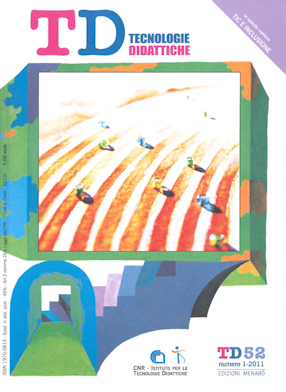Linguistic inclusion of the deaf and social networking: building knowledge on the web
Main Article Content
Abstract
Article Details
Section
Authors who publish with this journal agree to the following terms:
- Authors retain copyright and grant the journal right of first publication with the work simultaneously licensed under a Creative Commons CC BY 4.0 Attribution 4.0 International License.
- Authors are able to enter into separate, additional contractual arrangements for the non-exclusive distribution of the journal's published version of the work (e.g., post it to an institutional repository or publish it in a book), with an acknowledgement of its initial publication in this journal.
- Authors are permitted and encouraged to post their work online (e.g., in institutional repositories or on their website) prior to and during the submission process, as it can lead to productive exchanges, as well as earlier and greater citation of published work (See The Effect of Open Access)
References
Bagnasco A., Piselli F., Pizzorno A., Trigilia C. (2001). Il capitale sociale. Istruzioni per l’uso. Bologna: Il Mulino.
Balboni P. (1999). Dizionario di glottodidattica. Perugia: Guerra.
Benson P. (2001). Teaching and Researching Autonomy in Language Learning. London: Longman.
Bianchi L. (2004). L’accessibilità Web per gli utenti sordi. In R. Scano (ed.) Accessibilità: dalla teoria alla realtà - webstandards. Trento: IWA Italy Editions.
Bianco M. L. (1996). Classi e reti sociali. Bologna: Il Mulino.
Cagliani M.L., Chiappini G., Ott M. (2004). Educazione linguistica e bambini sordi: un esempio d’uso di software didattico. In Atti Didamatica 2004. Ferrara: Consorzio Omniacom Editori, pp.131-140.
Caselli M.C., Maragna S., Volterra V. (2006). Linguaggio e sordità. Bologna: Il Mulino.
Cohen S., Syme L. (eds.) (1985). Social support and health. Orlando, FL, USA: Academic Press.
Coleman J.S. (1988). Social Capital in the Creation of Human Capital. In The American Journal of Sociology, 94, Supplement: Organizations and Institutions: Sociological and Economic Approaches to the Analysis of Social Structure. Chicago, IL, USA: The University of Chicago Press, pp. 95- 120.
Cummins J. (1979). Cognitive/academic language proficiency, linguistic interdependence, the optimum age question and some other matters. Working Papers on Bilingualism, 19, pp. 121-129.
Di Nicola P. (1986). L’uomo non è un’isola. Le reti sociali primarie nella vita quotidiana. Milano: Franco Angeli.
Ellison L.B., Steinfield C., Lampe C. (2007). The benefits of Facebook “friends”: Social capital and college students use of online social network sites. Journal of Computer- Mediated Communication, 12(4), pp. 1143-1168.
Fabbretti D., Tomasuolo E. (2006). Scrittura e sordità. Roma: Carocci.
Folgheraiter F. (2004). Il metodo di rete in pratica. Trento: Erikson.
Krashen S (1981). Second language acquisition and second language learning. Oxford, UK: Pergamon Press.
Krashen S. (1982). Principles and practice in second language acquisition. Oxford, UK: Pergamon Press.
Lang H.G. (2002). Higher education for deaf students: Research priorities in the new millennium. Journal of Deaf Studies and Deaf Education, 7(4), pp. 267-280.
Maragna S., Nuccetelli G. (2008). An e-learning model for deaf people’s linguistic training. In Proceedings of the DEAL Project Final Meeting (Roma, 24 settembre 2008). Barcellona, Spagna: Publicacions y Edicions Universitat.
Marschark M., Spencer P.E. (2003). Oxford handbook of deaf studies, language, and education. New York, NY, U.S.A.: Oxford University Press.
Meadow-Orlans K.P., Spencer P.E., Erting C., Marschark M. (2000). The deaf child in the family and at school: essays in honor of Kathryn P. Meadow-Orlans. Mahwah, NJ, USA: Lawrence Erlbaum Associates.
Sanicola L. (ed.) (1995). Reti sociali e intervento professionale. Napoli: Liguori Edizioni.
Scott J. (2003). L’analisi delle reti sociali. Roma: Carocci.
Schrimer B.R. (2000). Language & Literacy development in children who are deaf. Second edition. Boston, MA, U.S.A.: Allyn&Bacon.
Selinker L. (1972). Interlanguage. IRAL, 10, pp. 209-231.
Spano I. (2007). Formazione come relazione. In I. Spano, S. Vigorelli (eds.). Per una ecologia della mente e del corpo. Riflessioni di Sociologia della salute. Padova: Logos Edizioni.
Spano I., Mazzon R. (2004). Il lavoro di rete come “mission” del terzo settore. Padova-Gibellina: Sapere Edizioni- CRESM.
Straetz K., Kaibel A., Raithel V., Specht M., Grote K., Kramer F. (2004). An e-learning environment for deaf adults. In C. Stary, C. Stephanidis (eds.). Conference Proceedings of the 8th ERCIM Workshop on User Interfaces for All, (Vienna, 28-29 giugno 2004). Heidelberg, Germany: Springer.
Vygotskij L.S. (1980). Il processo cognitivo. Torino: Bollati Boringhieri.

